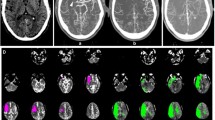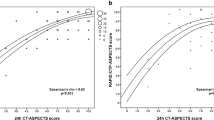Abstract
Objectives
CTP images analyzed with the Alberta stroke program early CT scale (ASPECTS) have been shown to be optimal predictors of clinical outcome. In this study we compared two biomarkers, the cerebral blood volume (CBV)-ASPECTS and the CTA-ASPECTS as predictors of clinical outcome after thrombectomy.
Methods
Stroke patients with thrombosis of the M1 segment of the middle cerebral artery were included in our study. All patients underwent initial multimodal CT with CTP and CTA on a modern CT scanner. Treatment consisted of full dose intravenous tissue plasminogen activator, when applicable, and mechanical thrombectomy. Three neuroradiologists separately scored CTP and CTA images with the ASPECTS score.
Results
Sixty-five patients were included. Median baseline CBV-ASPECTS and CTA-ASPECTS for patients with favourable clinical outcome at follow-up were 8 [interquartile range (IQR) 8-9 and 7-9 respectively]. Patients with poor clinical outcome showed a median baseline CBV-ASPECTS of 6 (IQR 5-8, P < 0.0001) and a median baseline CTA-ASPECTS of 7 (IQR 7-8, P = 0.18). Using CBV-ASPECTS and CTA-ASPECTS raters predicted futile reperfusions in 96 % and 56 % of the cases, respectively.
Conclusions
CBV-ASPECTS is a significant predictor of clinical outcome in patients with acute ischemic stroke treated with mechanical thrombectomy.
Key Points
• CBV-ASPECTS is a significant predictor of clinical outcome.
• Single phase CTA-ASPECTS has low predictive value.
• Using CBV-ASPECTS, raters identified futile reperfusions in 96 % of the cases.



Similar content being viewed by others
Abbreviations
- ASPECTS:
-
Alberta stroke program early CT score
- CBF:
-
Cerebral blood flow
- CBV:
-
Cerebral blood volume
- GSS:
-
Goettinger stroke scale
- ICC:
-
Interclass correlation coefficient
- IQR:
-
Interquartile range
- IV rtPA:
-
Intravenous recombinant tissue plasminogen activator
- MCA:
-
Middle cerebral artery
- mTICI:
-
Modified thrombolysis in cerebral infarction
- MTT:
-
Mean transit time
- mRS:
-
Modified Rankin scale
- NIHSS:
-
National Institutes of Health stroke scale
- NCCT:
-
noncontrast computed tomography
- NPV:
-
Negative predictive value
- PPV:
-
Positive predictive value
- TTD:
-
Time to drain
References
Cloft HJ (2011) Death and destruction in the intra-arterial battle with acute ischemic stroke. AJNR Am J Neuroradiol 32:1769–1770
Lansberg MG, Straka M, Kemp S et al (2012) MRI profile and response to endovascular reperfusion after stroke (DEFUSE 2): a prospective cohort study. Lancet Neurol 11:860–867
Psychogios MN, Kreusch A, Wasser K, Mohr A, Groschel K, Knauth M (2012) Recanalization of large intracranial vessels using the penumbra system: a single-center experience. AJNR Am J Neuroradiol 33:1488–1493
Nogueira RG, Lutsep HL, Gupta R et al (2012) Trevo versus Merci retrievers for thrombectomy revascularisation of large vessel occlusions in acute ischaemic stroke (TREVO 2): a randomised trial. Lancet 380:1231–1240
Berkhemer OA, Fransen PS, Beumer D et al (2015) A randomized trial of intraarterial treatment for acute ischemic stroke. N Engl J Med 372:11–20
Psychogios MN, Schramm P, Frolich AM et al (2013) Alberta Stroke Program Early CT Scale evaluation of multimodal computed tomography in predicting clinical outcomes of stroke patients treated with aspiration thrombectomy. Stroke 44:2188–2193
Zaidat OO, Yoo AJ, Khatri P et al (2013) Recommendations on angiographic revascularization grading standards for acute ischemic stroke: a consensus statement. Stroke 44:2650–2663
Abels B, Klotz E, Tomandl BF, Kloska SP, Lell MM (2010) Perfusion CT in acute ischemic stroke: a qualitative and quantitative comparison of deconvolution and maximum slope approach. AJNR Am J Neuroradiol 31:1690–1698
Ovbiagele B, Saver JL (2010) Day-90 acute ischemic stroke outcomes can be derived from early functional activity level. Cerebrovasc Dis 29:50–56
Aviv RI, Mandelcorn J, Chakraborty S et al (2007) Alberta stroke program early CT scoring of CT perfusion in early stroke visualization and assessment. AJNR Am J Neuroradiol 28:1975–1980
Kim JT, Park MS, Choi KH et al (2010) The CBV-ASPECT score as a predictor of fatal stroke in a hyperacute state. Eur Neurol 63:357–363
Lum C, Ahmed ME, Patro S et al (2014) Computed tomographic angiography and cerebral blood volume can predict final infarct volume and outcome after recanalization. Stroke 45:2683–2688
Schramm P, Schellinger PD, Klotz E et al (2004) Comparison of perfusion computed tomography and computed tomography angiography source images with perfusion-weighted imaging and diffusion-weighted imaging in patients with acute stroke of less than 6 hours' duration. Stroke 35:1652–1658
Sharma M, Fox AJ, Symons S, Jairath A, Aviv RI (2011) CT angiographic source images: flow- or volume-weighted? AJNR Am J Neuroradiol 32:359–364
Goyal M, Demchuk AM, Menon BK et al (2015) Randomized assessment of rapid endovascular treatment of ischemic stroke. N Engl J Med 372:1019–1030
Campbell BC, Mitchell PJ, Kleinig TJ et al (2015) Endovascular therapy for ischemic stroke with perfusion-imaging selection. N Engl J Med 372:1009–1018
Saver JL, Goyal M, Bonafe A et al (2015) Stent-retriever thrombectomy after intravenous t-PA vs. t-PA alone in stroke. N Engl J Med
Jovin TG, Chamorro A, Cobo E et al (2015) Thrombectomy within 8 hours after symptom onset in ischemic stroke. N Engl J Med
Espinosa de Rueda M, Parrilla G, Manzano-Fernandez S et al (2015) Combined multimodal computed tomography score correlates with futile recanalization after thrombectomy in patients with acute stroke. Stroke 46:2517–2522
Vagal A, Menon BK, Foster LD et al (2015) Association between CT angiogram collaterals and CT perfusion in the interventional management of stroke III trial. Stroke
Menon BK, d'Esterre CD, Qazi EM et al (2015) Multiphase CT angiography: a new tool for the imaging triage of patients with acute ischemic stroke. Radiology 275:510–520
Fahmi F, Marquering HA, Streekstra GJ et al (2012) Differences in CT perfusion summary maps for patients with acute ischemic stroke generated by 2 software packages. AJNR Am J Neuroradiol 33:2074–2080
Lee JH, Kim YJ, Choi JW et al (2013) Multimodal CT: favorable outcome factors in acute middle cerebral artery stroke with large artery occlusion. Eur Neurol 69:366–374
Acknowledgments
The scientific guarantor of this publication is Dr. Marios Nikos Psychogios. The authors of this manuscript declare no relationships with any companies, whose products or services may be related to the subject matter of the article. The authors state that this work has not received any funding. One of the authors has significant statistical expertise. Institutional Review Board approval was obtained. Written informed consent was waived by the Institutional Review Board. We would like to inform you that part of the current patient collective (about one-third of the population) has been subject to previous analyses: Frölich AM, Wolff SL, Psychogios MN et al. (2014) Time-resolved assessment of collateral flow using 4D CT angiography in large-vessel occlusion stroke. Eur Radiol 24(2):390-6. Methodology: retrospective, observational, performed at one institution.
Author information
Authors and Affiliations
Corresponding author
Rights and permissions
About this article
Cite this article
Tsogkas, I., Knauth, M., Schregel, K. et al. Added value of CT perfusion compared to CT angiography in predicting clinical outcomes of stroke patients treated with mechanical thrombectomy. Eur Radiol 26, 4213–4219 (2016). https://doi.org/10.1007/s00330-016-4257-y
Received:
Revised:
Accepted:
Published:
Issue Date:
DOI: https://doi.org/10.1007/s00330-016-4257-y




